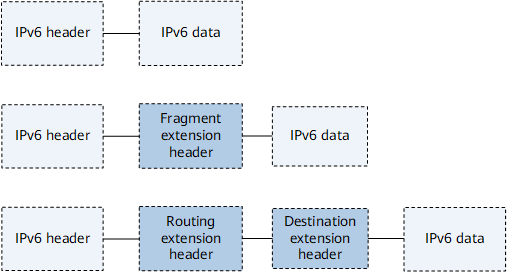IPv6 Features
IPv6 supports the following features:
Hierarchical address structure
The IPv6 hierarchical address structure facilitates route search, reduces the IPv6 routing table size using route aggregation, and improves the forwarding efficiency of routers.
Automatic address configuration
IPv6 supports stateful and stateless address autoconfiguration to simplify the host configuration process.
In stateful address autoconfiguration, the host obtains the address and configuration from a server.
In stateless address autoconfiguration, the host automatically configures an IPv6 address that contains the prefix advertised by the local router and interface ID of the host. If no router exists on the link, the host can only configure the link-local address automatically to interwork with local nodes.
Selection of source and destination addresses
When network administrators need to specify or plan source and destination addresses of packets, they can define a group of address selection rules. An address selection policy table can be created based on these rules. Similar to a routing table, this table is queried based on the longest matching rule. The address is selected based on the source and destination addresses.
Select a source address using the following rules in descending order of priority:
- Prefer a source address that is the same as the destination address.
- Prefer an address in an appropriate address range.
- Avoid selecting a deprecated address.
- Prefer a home address.
- Prefer an address of the outbound interface.
- Prefer an address whose label value is the same as that of the destination address.
- Use the longest matching rule.

The candidate address can be the unicast address that is configured on the specified outbound interface. If a source address that has the same label value and is in the same address range with the destination address is not found on the outbound interface, you can select such a source address from another interface.
Select a destination address using the following rules in descending order of priority.
- Avoid selecting an unavailable destination address.
- Prefer an address in an appropriate address range.
- Avoid selecting a deprecated address.
- Prefer a home address.
- Prefer an address whose label value is the same as that of the source address.
- Prefer an address with a higher precedence value.
- Prefer native transport to the 6over4 or 6to4 tunnel.
- Prefer an address in a smaller address range.
- Use the longest matching rule.
- Leave the order of address priorities unchanged.
QoS
In an IPv6 header, the new Flow Label field specifies how to identify and process traffic. The Flow Label field identifies a flow and allows a router to recognize packets in the flow and to provide special processing.
QoS is guaranteed even for the packets encrypted with IPsec because the IPv6 header can identify different types of flows.
Built-in security
An IPv6 packet contains a standard extension header related to IPsec, and therefore IPv6 can provide end-to-end security. This provides network security specifications and improves interoperability between different IPv6 applications.
Fixed basic header
A fixed basic header helps improve forwarding efficiency.
Flexible extension header
An IPv4 header only supports the 40-byte Options field, whereas the size of the IPv6 extension header is limited only by the IPv6 packet size.
In IPv6, multiple extension headers are introduced to replace the Options field of the IPv4 header. This improves packet processing efficiency, enhances IPv6 flexibility, and provides better scalability for the IP protocol. Figure 1 shows an IPv6 extension header.
When multiple extension headers are used in the same packet, the headers must be listed in the following order:
IPv6 basic header
Hop-by-hop extension header
Destination options extension header
Routing extension header
Fragment extension header
Authentication extension header
Encapsulation security extension header
Destination options extension header (options to be processed at the destination)
Upper layer extension header
Not all extension headers must be examined and processed by routers. When a router forwards packets, it determines whether or not to process the extension headers based on the Next Header value in the IPv6 basic header.
The destination options extension header appears twice in a packet: one before the routing extension header and one after the upper layer extension header. All other extension headers appear only once.
